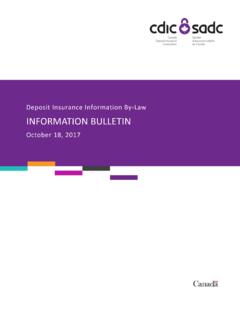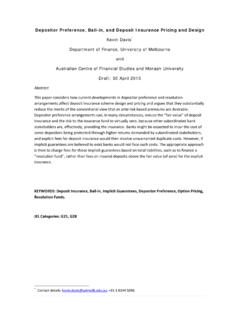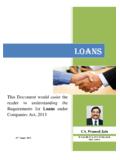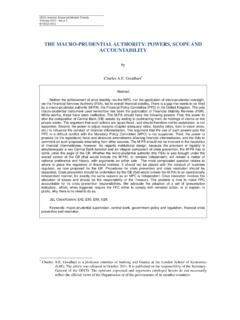Transcription of Guidance on the Exercise of Eligible Financial …
1 Guidance on the Exercise of Eligible Financial Contracts Close-out Rights in a resolution Scenario March 1, 2018 Guidance on the Exercise of Eligible Financial Contracts Close-out Rights in a resolution Scenario - Canada Deposit Insurance Corporation | Soci t d assurance-d p ts du Canada 2 This Guidance note1 provides an overview of the framework for the treatment of Eligible Financial contracts ( EFCs )2 between CDIC federal member institutions ( FIs ) and their contractual counterparties in the context of the resolution of a FI under the Canada Deposit Insurance Corporation Act (the CDIC Act ). Where a non-viable FI enters resolution , certain rights of EFC counterparties to terminate or accelerate obligations and to deal with Financial collateral (collectively, Close-Out Rights ) are stayed under the CDIC In keeping with the Financial Stability Board s Key Attributes of resolution Regimes for Financial Institutions (the FSB Key Attributes ), the stays on Close-Out Rights are limited.
2 The framework is designed to strike a balance between a robust resolution toolkit that prevents mass termination of EFCs in the resolution of a FI and adequate safeguards for the rights of EFC counterparties to manage their risk. CDIC and resolution CDIC is a Crown corporation designated in the CDIC Act as the resolution authority for its member institutions. CDIC has the ability to resolve a non-viable FI through a number of resolution tools described below. In keeping with the FSB Key Attributes, resolution actions under the CDIC Act can and are intended to be taken before the FI is balance sheet insolvent. Where the Superintendent of Financial Institutions (the Superintendent ) is of the opinion that a FI has ceased, or is about to cease, to be viable and the viability of the FI cannot be restored or preserved by the Exercise of the Superintendent s powers, the Superintendent must report on that to CDIC.
3 CDIC may request the Minister of Finance (the Minister ) to recommend, if he or she is of the opinion that it is in the public interest to do so, one or more orders (a resolution Order ) under the CDIC Act to the Governor in Council ( federal cabinet) for the orderly resolution of the non-viable FI. 1 This note has been developed following amendments made to CDIC Act by the Budget Implementation Act, 2017, No. 2, which came into force on December 14, 2017. It does not constitute legal advice. It is intended as a general summary of the current legislative framework and the process of resolution .
4 2 EFCs include derivatives, swaps, repurchase agreements and similar contracts. See definition of EFCs in Eligible Financial Contract Regulations (CDIC Act), SOR/2007-255, as amended. 3 See paragraphs (a), (b) and (f) of subsection (7) of the CDIC Act. Guidance on the Exercise of Eligible Financial Contracts Close-out Rights in a resolution Scenario - Canada Deposit Insurance Corporation | Soci t d assurance-d p ts du Canada 3 On the recommendation of the Minister, the Governor in Council may decide whether a resolution Order should be made and, if so, which resolution Order(s) to make. The Governor in Council may make one or more of the following resolution Orders: a) vest in CDIC the shares and subordinated debt of the FI that are specified in the order; b) appoint CDIC as receiver in respect of the FI; c) direct the Minister to incorporate a federal institution designated in the order as a bridge institution and specify the date and time as of which the FI s deposit liabilities are assumed.
5 Or, d) direct CDIC to carry out a conversion, in whole or in part by means of a transaction or series of transactions and in one or more steps of the FI s shares and liabilities that are prescribed by the regulations4 into common shares of the FI or of any of its affiliates ( bail-in). The resolution tools available to CDIC will be determined by the resolution Order(s). Consequently, through the resolution Order(s) and public communications, it would be clear to market participants at the outset of the resolution which - or what combination of - resolution tools and accompanying stabilization measures would be pursued in respect of the FI.
6 resolution Stays of Close-Out Rights Generally, where a resolution Order is made, counterparties to a FI s agreements are prohibited from terminating or amending their agreements for a number of resolution -related reasons, such as the insolvency or deteriorated Financial condition of the FI, non-monetary default by the FI before the resolution Order was made, a monetary default by the FI before the resolution Order that is remedied within 60 days after the day of the order, or the making of the resolution Order. The CDIC Act provides a safe harbour for EFCs from these general stay provisions, similar to the safe harbour under Canadian insolvency laws, with certain limits discussed below.
7 On the one hand, it is recognized that the legal enforceability of Close-Out Rights under EFCs promotes and contributes to the stability of the Canadian Financial system. On the other hand, mass termination or acceleration of EFCs in the context of the resolution of a FI could result in a disorderly rush for the exits that creates further market instability and frustrates the implementation of resolution tools. Accordingly, the CDIC Act places certain limits on the Exercise of Close-Out Rights when a resolution Order is made, in keeping with the FSB Key Attributes. 4 As at the date of this Guidance , the bail-in regulations have not yet been enacted by the Governor in Council.
8 Guidance on the Exercise of Eligible Financial Contracts Close-out Rights in a resolution Scenario - Canada Deposit Insurance Corporation | Soci t d assurance-d p ts du Canada 4 No Stay As a starting point, it is important to note that certain rights of EFC counterparties are not affected by the stays. Where a resolution Order is made, EFC counterparties can Exercise remedies for a failure to satisfy an obligation under or in connection with the EFCs, including payment or delivery obligations. They can deal with Financial collateral to satisfy any payment, delivery or settlement obligations. They can also Exercise netting or set-off rights under or in connection with the EFCs (except as may be limited as a result of the resolution stays discussed below).
9 EFC counterparties can Exercise any other Close-Out Rights unless they are stayed for reasons covered by the resolution stays discussed below. resolution Stays Where a resolution Order is made, EFC counterparties5 would be stayed from exercising Close-Out Rights by reason only of the following: the insolvency or deteriorated Financial condition of the FI, any of its affiliates or credit support providers or guarantors (the Insolvency/DFC ) the making of a resolution Order or any change of control or ownership of the FI or any of its affiliates that is related to the making of the order; the assignment or assumption of the EFC to or by a bridge institution or a third party; a bail-in conversion (as discussed under Open Bank resolution below).
10 And/or, a conversion of any of the FI s shares or liabilities in accordance with their contractual terms (for example, non-viability contingent capital (known as NVCC ) instruments). The stay for reason only of the Insolvency/DFC (the Temporary Stay ) ceases to apply automatically at 5:00 on the second business day after the day on which the resolution Order was After the Temporary Stay ceases to apply, EFC counterparties can rely on the Insolvency/DFC to Exercise Close-Out Rights as long as that Insolvency/DFC still exists at the time the Temporary Stay ceases. In their Exercise of Close-Out Rights, EFC counterparties are not prevented from pointing to the facts that led to the making of the resolution Order as evidence of the Insolvency/DFC.










